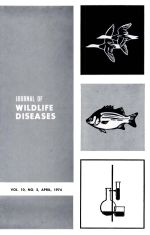A ten-year serologic and virologic investigation into the activity of enzootic bluetongue (BT) virus was conducted in southern Texas white-tailed deer (Odocoileus virginianus texanus). Eighty-nine percent of 484 adult deer, 36% of 129 juvenile deer and 93% of 182 neonatal deer were sero-positive of BT. Antibody was not detected in fetal fawns but was found in colostrum samples. Sentinel fawn studies demonstrated that maternal antibody persists at least 8 weeks and that BT was transmitted during the fall months. The virus was isolated from a sentinel fawn but could not be recovered from deer with antibody or with organizing lesions suggestive of previous BT infection. Virus was not isolated from deer ectoparasites.
How to translate text using browser tools
1 April 1974
BLUETONGUE VIRUS AND WHITE-TAILED DEER IN AN ENZOOTIC AREA OF TEXAS
GERALD L. HOFF





